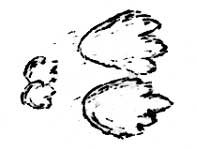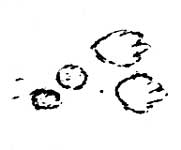THE VARYING HARE OR SNOWSHOE RABBIT
(Lepus americanus var.)
Varying Hares and White Rabbits (or Snowshoe Rabbits, as they are
commonly known) are very numerous throughout the forested areas of the
Park. They are not rabbits but true hares of the genus Lepus and are
the only representatives of either group found in the Park region.
Being largely nocturnal in habits they do not make up a conspicuous part
of the fauna but are, nevertheless, well distributed. They are seen,
occasionally, on mornings and evenings, - particularly during the spring
and late fall - in the woods and on patches of green lawn. A flower or
a vegetable garden is sufficient to induce them to take up their
residence nearby. In size and in summer-coloring they resemble the
common Cottontail Rabbit of the East. Their color also varies according
to the season. In winter their broad hind feet, with their long,
spreading toes, are entirely covered with long, coarse hair which form
snowshoe-like pads allowing their owners to move over the soft snow with
unusual freedom. This peculiarity has given rise to one of the common
names. The protective coloration enjoyed by the Varying Hare accounts
for another of the common names and is perhaps its chief point of
interest. Living in a region where snow lays on the ground from a few
to many feet in depth for at least five months of the year and
continually harassed by such persistent enemies as the lynx, coyote and
great gray owls, it is a peculiar advantage to the Snowshoe Rabbit to
resemble, as nearly as possible, the surrounding landscape. Therefore,
in winter, when all the world is robed in pure white the little rabbit
also wears a spotless coat of white but no sooner does the snow begin to
disappear and brown spots to spread over the forest floor than brown
spots appear on the rabbit. In the spring when all the snow has
departed and the forest floor is entirely brown the Varying Hare is the
same color. For many years it was thought by naturalists that this
change was due to the fact that the hairs change color at the approach
of the first snows in the winter and at their disappearance in the
spring but it has recently been definitely proven that the charge is due
entirely to moult, just as are similar changes in the ptarmigan and the
Arctic Owl. There are two species of weasel also found within the Park
that go through like changes. With the weasel and the owl, however, it
is likely that the white winter coats serves them best by making them
inconspicuous to their intended victims rather than as protection from
their own enemies.
Probably because of the fact that they commonly inhabit low-lying and
often swampy river bottom, the Varying Hare is not adverse to entering
the water, as many of the rabbits are. They often swim across the small
streams encountered on their wanderings. The tracks, which are often in
large numbers after the first fall of snow in the winter, are
unmistakable. The hind feet, which are placed before the front feet
when travelling, are at least four times the size of the front feet.
Tracks of the Snowshoe Rabbit, compared with the tracks of the
Cottontail Rabbit, appear thus:
Snowshoe Rabbit
 |
Cottontail Rabbit
 |
Lower down in the dark forest of the humid coast belt (which extends
from the edges of the Olympic Peninsula and the borders of Puget Sound
to the lower valleys of the Park) there is a closely-related species
called the Washington Hare (Lepus washingtoni) which although it has the
large rear feet does not have the seasonal variation of color. In this
zone there is very little snowfall to affect its pelage. The mating
season occurs early in the spring, when the males become very restless
and are often seen fighting or chasing each other. At this season, was
well as at other seasons, Snowshoe Rabbits have a habit of thumping
rapidly on the ground with their hind feet thereby making a dull
drumming sound which is audible some distance. The young, usually about
four or five in number, are born in warm nests hidden under dense
vegetation and lined with hair from the mother's body. They have their
eyes open and are fully formed and perfect little rabbits at birth.

